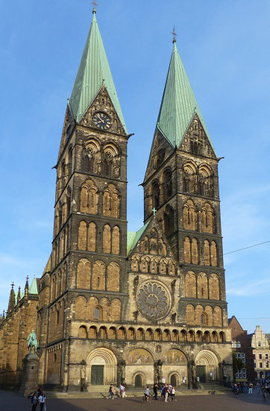The Saint Petri cathedral is a Romanic church made out of sandstone and bricks. The cathedral was built in the 11th century and was rebuilt in the style of gothic art until the 13th century. There were expansions around lateral chapels. In 1502 structural alteration works began, that changed the church into a late gothic hall church. The construction works stopped as the reformation began. In the late 19th century, extensive renovations of the strongly neglected construction started. They tried to keep the old form. Today, the Lord’s house belongs to the Evangelic-Lutheran cathedral parish St. Petri. Since 1973 the Saint Peters cathedral is declared a historic monument. The place on the site of today's Saint Peters cathedral, the highest point of the Weser dune in midst of the settlement has become the city core with the construction of the church. The construction was initiated by the Anglo-Saxon missionary bishop Willehad. The timber work was burnt and destructed in 792, 3 years after its completion in course of the Saxon war. After Willehad’s death in 798, there neither was a new bishop nor a cathedral in Bremen for 13 years. In 805 the construction of a new cathedral (out of stone) started under the direction of bishop Willerich. The construction dragged on for many years.
Protestantism in Bremen
When the Protestant Reformation swept through northern Germany, the first reformed preach in Bremen was held in 1522, and in 1534 the city established a Protestant rule of churches. The cathedral chapter was still catholic and closed St Peter's cathedral, after in 1532 a mob of Bremen's burghers had forcefully interrupted a Catholic mass and prompted a pastor to hold a Lutheran service. Roman Catholic Church was condemned as a symbol of the abuses of a long Catholic past by most local citizens and the building fell into disuse and then disrepair. In 1547 the chapter, meanwhile prevailingly Lutheran, appointed the Dutch Albert Hardenberg, called Rizaeus, as the first Cathedral preacher of Protestant affiliation. Rizaeus turned out to be a partisan of the rather Zwinglian understanding of the Lord's Supper, which was rejected by the then Lutheran burghers, city council, and chapter. So in 1561 - after tremendous quarrels - Rizaeus was dismissed and banned from the city and the cathedral shut again its doors. While the majority of Bremen's burghers and city council adopted Calvinism until the 1590s, the chapter, being simultaneously the body of secular government in the neighboring Prince-Archbishopric, clung to Lutheranism.

